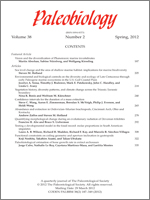The clade Archosauria contains two very different sister groups in terms of diversity (number of species) and disparity (phenotypic variation): Crurotarsi (taxa more closely related to crocodiles than to birds) and Ornithodira (pterosaurs and dinosaurs including birds). The extant species of Crurotarsi may constitute a biased sample of past biodiversity regarding growth patterns and metabolic rates. Bone histological characters can be conserved over hundreds of millions of years in the fossil record and potentially contain information about individual age at death, age at sexual maturity, bone growth rates, and basal metabolic rates of extinct vertebrates. Using a sample of extant amniotes, we have constructed a paleobiological model to estimate bone growth rate from bone histological traits. Cross-validation tests show that this model is reliable. We then used it to estimate bone growth rates in a sample of extinct archosaurs including Crurotarsi and Ornithodira. After testing for phylogenetic signal, optimization of femoral growth rates through squared change parsimony onto a time-calibrated tree of amniotes shows two divergent evolutionary trends: whereas bone growth rates increase from the last common ancestor of Ornithodira to extant birds, they decrease from the last common ancestor of Crurotarsi to extant crocodiles. However, we conclude, on the basis of recent evidence for unidirectional airflow in the lungs of alligators, that crocodiles may have retained the capacity of growing at high rates.
How to translate text using browser tools
1 March 2012
Paleohistological estimation of bone growth rate in extinct archosaurs
Jorge Cubo,
Nathalie Le Roy,
Cayetana Martinez-Maza,
Laetitia Montes
ACCESS THE FULL ARTICLE
<
Previous Article
|

Paleobiology
Vol. 38 • No. 2
Spring 2012
Vol. 38 • No. 2
Spring 2012




